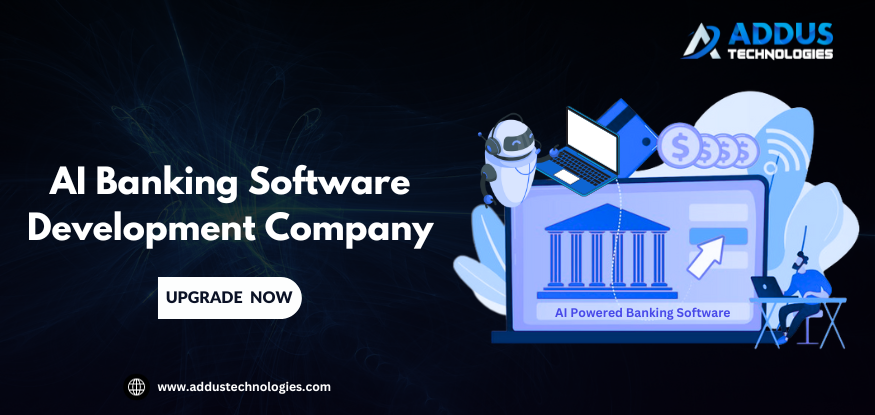AI Banking Software Development – Modernising the Banking Sector for the Future

The brilliant customer of the current world needs safe and secure ways to spend, save, access, and invest money. So for that Banks are moving to achieve another level of milestone for improving the customer’s experience. ATM Machines, Card Payments, Mobile Banking, and more. This exemplifies how the banking industry is always growing and believing in technological breakthroughs like never before.
The latest technologies, like Artificial Intelligence, Blockchain technology, and Robotic process automation are unruly changes to the banking industry. The advancement of client-focused technology has resulted in some incredible applications of these technologies in the banking and financial sectors. In this blog, we are going to discuss the groundbreaking applications of Artificial Intelligence(AI) in the banking industry.
Applications of AI in Banking and Finance
Artificial Intelligence has performed in a major part of our world, and the banking sector also already started to integrate these technologies into their products and services. Below we are mentioning some of the major AI applications in the banking industry:
Fraud Detection & Cybersecurity
When we hear of a fraud-related incident, the banking industry is often the first to come to mind, which is both strange and worrisome. Well, it’s evident in numerous ways since that’s where the majority of the scams take place.
These incidents, however, have decreased in quantity, thanks to AI and its capacity to reduce risks, uncover gaps, and improve security. With the use of its algorithms, it can notify both the financial system and the concerned user.
As an alternative, cybersecurity has grown as well with its implementation in the banking business, because of AI’s continual monitoring capabilities. It may notify banks and users about possible dangers and rescue them from financial disasters.
Chatbots
Chatbots are the most suitable examples of real-world applications of artificial intelligence in the banking sector. Once we implement AI, it will be working 24/7, in contrast to people who have set working hours.
Furthermore, they continue to learn about certain customers’ usage patterns. It enables them to efficiently comprehend a user’s requirements.
AI banks may ensure that they are available to their consumers around the clock by including chatbots in their banking apps. Furthermore, by learning consumer behavior, chatbots may provide personalized customer care, minimize workload on email and other channels, and promote appropriate financial services and products.
Loan and Credit Decisions
Banks are now starting to use AI-based technologies in order to arrive at smarter, safer, and more profitable lending and credit decisions. Many AI banks are still overly dependent on credit records, credit ratings, and client recommendations to establish a person’s or organization’s trustworthiness.
However, these credit reports for reporting creditworthiness are frequently riddled with mistakes, missing real-world transaction histories, and incorrectly identifying creditors.
To establish creditworthiness, an AI-powered loan and credit system can examine the behavior and patterns of consumers with minimal credit records. In addition, the system provides alerts to banks about particular actions that may raise the possibility of defaults. In brief, these kinds of innovations are playing a critical role in shaping the future of consumer finance.
Data Collection and Analysis
Every single day banking and financial sectors maintain billions of transaction records. Because the amount of data constructed is large, employees find it difficult to collect and register it. It seems difficult to structure and keep track of such an enormous quantity of data without mistake.
In such cases, modern AI banking solutions assist in effective data collecting and processing. As a result, everything that users experience improves. The data can also be utilized to identify fraudsters or make decisions regarding credit.
Risk Assessment and Credit Scoring
Banking is a highly unpredictable sector, making it especially susceptible to market changes caused by outside factors such as natural disasters, pandemics, and political concerns. In this case, AI can assist banks by forecasting risks and giving applicable solutions to reduce the impact of risk on ordinary people.
Don’t worry, AI does not anticipate these patterns of behavior on its own; it does so by analyzing the client’s previous behavior. This behavior investigation instrument can also assist AI banks in determining the probability of a customer’s failure to repay a loan. In this approach, AI can assist the bank in risk assessment.
Meanwhile, for understanding financial standing, AI applies a similar technique of analyzing the customer’s historical payment behavior. If the consumer has a poor history, AI will advise the bank to take cautious measures and protect it.
Process Automation
Process Automation is an attribute for increasing a system’s performance. It creates an automated method for responding to the most frequently asked queries, allowing workers to focus their time on other user-centered tasks that require their personal assistance.
Many financial institutions have used this technology in today’s fast-paced industry, resulting in significant time savings and increased productivity by providing value to more important problems. If you’re curious about all of the repetitive chores that the AI banking business has to deal with, consider the following: account opening, KYC completion, customer support, and others.
Customer Experience
Customers constantly search for improved experiences and increased convenience. For instance, ATMs were a success because they allowed users to access necessary services like money withdrawal and deposit even outside of bank business hours.
This level of convenience has only fueled more creativity. Customers can now open bank accounts using their smartphones from the comfort of their own homes.
Applying AI in banking and finance services improves the consumer experience and promotes user convenience. AI technology shortens and eliminates the time required to record Know Your Customer (KYC) information. Furthermore, new items and financial offers are made available on time.
[Also Read: Fintech App Development: Empowering the Future of Banking and Payments]
Steps to Integrate AI in Banking
Strategic Research
Everything begins with research. Investigate deeply and effectively how you want to accomplish your goals. This stage may involve N aspects to examine, such as your organization’s goals, vision, and values.
Market research fills the gap between what is missing and how it can be filled. Another critical component is the refinement of algorithms and database regulations and procedures to provide clear advice across all operational AI banking divisions.
Plan a Process
This stage covers identifying the relevant technologies that will be used to install AI in the financial system. Another critical consideration is the extent to which these technologies will be deployed.
Following this discussion, AI banks must determine the suitability and practicality of these technologies. This stage concludes with the distribution of a strategy for implementation, which includes information such as the necessary quantity of programmers, essential expertise, data scientists, and other team members.
Development Stage
After investigation and preparation, the subsequent and most significant stage is development, hence it is critical to employ a reputable software development business. Building prototypes, testing prototypes, feeding algorithms, and so on.
Once the AI-based algorithm is complete, it must be tested to see if any changes are required. Your AI-integrated financial system is now ready for deployment. Following the rollout, AI banks can use user data to continuously enhance the system.
Deployment
Deploying the AI model is the most important step. Once launched, production data begins to flow in. AI starts working automatically. As new data becomes available, institutions may refine and update the model on a regular basis.
Monitoring & Maintenance
The final thing to do is to track and maintain an eye on the servicing of their systems. Monitoring is an important component since it drives the AI banking system to regularly enhance its system and give a better client experience.
Benefits of Using AI in Financial Institution Development:
-
Artificial intelligence has the ability to perform many typical manual operations, increasing productivity and time efficient.
-
Improved Accuracy – AI in FinTech can analyze large amounts of data, it can dramatically improve the accuracy of financial industry projections and judgments.
-
Experience has shown that AI may boost client happiness and retention by offering clients faster and more personalized service.
-
Artificial intelligence has the ability to automate formerly manual operations, cutting labor costs and improving earnings for financial services firms.
-
AI’s capacity to analyze data and deliver current information permits real-time decision-making, allowing choices to be made more rapidly and with greater precision, which is a vital help for advisors, salespeople, or investors.
-
JPMorgan Chase
-
Capital One
-
A European Bank
-
Goldman Sachs
-
Merrill Lynch
Real-World Examples of AI in Banking
As previously said, a few big financial institutions are currently starting to use artificial intelligence technologies to improve the level of service, detect fraud and cybersecurity concerns, and improve customer experience.
Here are a few real-world examples of banks taking full advantage of artificial intelligence.
Conclusion:
AI banking software development services are crucial in altering the financial sector. AI technology integration provides unrivaled productivity, precision, and solutions that prioritize clients. AI has fueled development across the whole banking ecosystem, from improving client satisfaction through chatbots to revolutionizing fraud detection, credit scoring, investment strategies, and risk management. As the banking industry embraces Artificial intelligence, it is evident that these breakthroughs will reshape how financial institutions operate and engage with their consumers in the coming years.

